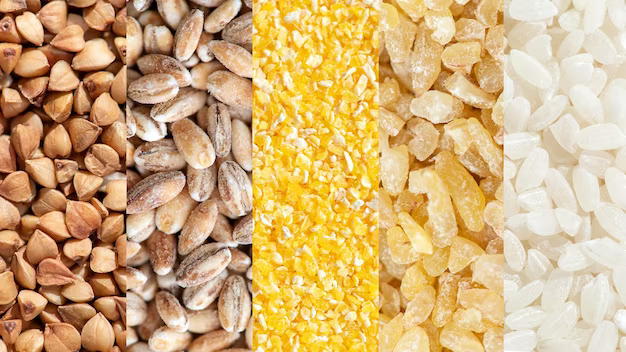

Unveiling the Truth: Is Barley a Millet? Exploring the Distinctions and Similarities
Barley and millet are both grains that have been cultivated for thousands of years and have played significant roles in various cuisines around the world. While they may share some similarities, they are distinct grains with unique characteristics. This article aims to shed light on the truth behind the question: Is barley a millet?
Understanding Barley: Characteristics and Uses
Barley, scientifically known as Hordeum vulgare, is a cereal grain that belongs to the grass family. It is one of the oldest cultivated grains and has been a staple food in many cultures. Barley grains are oval-shaped and have a tough outer husk that needs to be removed before consumption.
Barley has a chewy texture and a nutty flavor, making it a versatile ingredient in various dishes. It is commonly used to make barley flour, barley flakes, and pearl barley. Barley is known for its high fiber content, which aids digestion and promotes a healthy gut. It also contains essential vitamins and minerals, including vitamin B6, iron, and magnesium.
Exploring Millet: A Versatile Grain
Millet is a small-seeded grain, scientifically known as Panicum miliaceum or Pennisetum glaucum, depending on the variety. It is native to Africa and Asia and has been cultivated for thousands of years. Millet is a gluten-free grain, making it a suitable alternative for individuals with gluten intolerance or celiac disease.
Millet grains vary in color, including yellow, white, and red. They have a mild flavor and a slightly sweet, nutty taste. Millet is highly versatile and can be used in various forms, such as whole millet, millet flour, and millet flakes. It is often used in baking, as a rice substitute, or in porridges, salads, and side dishes.
Barley vs. Millet: Examining the Differences
Despite some similarities, barley and millet are distinct grains with several differences. One of the primary differences lies in their botanical classification. Barley is classified as a member of the grass family, while millet belongs to the family Poaceae. This classification affects their genetic makeup and growth characteristics.
Another difference is their appearance. Barley grains are larger and have a more elongated shape compared to the small, round grains of millet. Barley also has a tougher outer husk that needs to be removed, while millet does not require husking.
In terms of taste and texture, barley has a chewy texture and a nutty flavor, while millet has a softer texture and a slightly sweet, nutty taste. These differences in texture and taste contribute to the unique culinary uses of each grain.
Nutritional Comparison: Barley vs. Millet
When it comes to nutritional content, both barley and millet offer various health benefits. Barley is rich in dietary fiber, vitamins, and minerals. It is an excellent source of manganese, selenium, and phosphorus. Barley's high fiber content helps regulate blood sugar levels, lower cholesterol, and promote a healthy digestive system.
On the other hand, millet is also a nutritious grain. It is rich in antioxidants, particularly phenolic compounds, which have been linked to reducing the risk of chronic diseases. Millet is also a good source of protein, dietary fiber, and essential minerals such as magnesium and phosphorus.
While both grains offer nutritional benefits, the specific nutrient content may vary depending on the variety and processing method. It is essential to incorporate a diverse range of grains into a balanced diet to obtain a wide range of nutrients.
Culinary Uses: Barley and Millet in Cooking
Barley and millet have been used in various cuisines around the world, showcasing their versatility in the culinary world. Barley is commonly used in soups, stews, and salads, adding a chewy texture and nutty flavor. It can also be ground into flour and used in baking bread, muffins, and cookies.
Millet, on the other hand, is often used as a rice substitute in pilafs, stir-fries, and side dishes. It can also be ground into flour and used in gluten-free baking. Millet's mild flavor makes it a suitable grain to pair with different ingredients and spices, allowing for endless culinary possibilities.
Barley and Millet in Traditional Cuisines
Barley and millet have been integral to traditional cuisines in various cultures. In many Middle Eastern countries, barley is used in traditional dishes like tabbouleh, a salad made with bulgur wheat, parsley, and tomatoes. In Scotland, barley is a key ingredient in the traditional dish called Scotch broth, a hearty soup made with lamb, barley, and vegetables.
Millet has been a staple grain in parts of Africa and Asia for centuries. In India, millet is used to make roti, a type of unleavened bread. In Nigeria, millet is used to make a traditional porridge called pap, which is often served as a breakfast dish.
Is Barley a Millet? Debunking the Myth
Despite occasional confusion, barley is not a type of millet. They are different grains with distinct characteristics, origins, and uses. Barley is a member of the grass family, while millet belongs to the family Poaceae.
The confusion may arise from the fact that both barley and millet have been cultivated for thousands of years and have played significant roles in various cuisines. However, it is important to recognize their unique qualities and appreciate them as separate grains.
The Classification of Barley and Millet
Barley and millet have different botanical classifications. Barley belongs to the grass family, specifically the genus Hordeum. Millet, on the other hand, belongs to the family Poaceae, which includes other grains such as rice, wheat, and corn.
Understanding their classifications can help clarify their differences and dispel any misconceptions about their relationship. Barley and millet are distinct grains with their own characteristics and uses.
Conclusion: Embracing the Unique Qualities of Barley and Millet
In conclusion, barley and millet are both ancient grains that have stood the test of time. While they may share some similarities, they are distinct grains with their own unique characteristics, origins, and culinary uses.
Barley is a versatile grain with a chewy texture and nutty flavor, commonly used in soups, stews, and baking. Millet, on the other hand, is a gluten-free grain with a mild flavor, often used as a rice substitute and in gluten-free baking.
By understanding and appreciating the distinctions between barley and millet, we can embrace the unique qualities of each grain and incorporate them into our culinary repertoire. So whether you're cooking up a hearty barley soup or experimenting with millet in a stir-fry, enjoy the diverse world of grains and the flavors they bring to the table.
Have you tried cooking with barley or millet? Share your favorite recipes in the comments below and explore the endless possibilities of these ancient grains.
